Trichophyton
Rippon (1988) accepted 22 species and four varieties in the genus Trichophyton based on morphology. DNA sequences now play a prominent role in delineating phylogenetic relationships, and as such species concepts in Trichophyton have changed. Sixteen species are now recognised in the genus.
The descriptions and species concepts provided in this publication are based upon a combination of traditional morphological criteria and the current (2016) recognised phylogenetic species (de Hoog et al. 2017).
-
Trichophyton concentricum

Tinea imbricata caused by T. concentricum.
Trichophyton concentricum is an anthropophilic fungus which causes chronic widespread non-inflammatory tinea corporis known as tinea imbricata because of the concentric rings of scaling it produces. It is not known to invade hair. Infections among Europeans are rare. Distribution is restricted to the Pacific Islands of Oceania, South East Asia and Central and South America.
RG-2 organism.

Trichophyton concentricum culture showing a typical slow growing, heaped and folded, glabrous to suede like colony and the formation of typical balloon-shaped chlamydospores.
Note: Microconidia and macroconidia are usually not produced.Morphological description:
Colonies are slow growing, raised and folded, glabrous becoming suede-like, mostly white to cream-coloured, but sometimes orange-brown coloured, often deeply folded into the agar which may produce splitting of the medium in some cultures. Reverse is buff to yellow-brown to brown in colour. Cultures consist of broad, much-branched, irregular, often segmented, septate hyphae which may have “antler” tips resembling T. schoenleinii. Chlamydospores are often present in older cultures. Microconidia and macroconidia are not usually produced, although some isolates will produce occasional clavate to pyriform microconidia. Note: Hyphal segments may artificially resemble macroconidia.Confirmatory tests:
Hydrolysis of urea:
Negative after 7 days.Vitamin free agar (Trichophyton agar No.1):
Growth occurs on vitamin free agar (T1) but is usually slightly better on media containing thiamine i.e. T3 = T1 + thiamine and inositol, and T4 = T1 + thiamine. The slight enhancement of growth in the presence of thiamine helps to distinguish T. concentricum from T. schoenleinii, although this does not occur in all strains.Hair perforation test:
Negative at 28 days.Key features:
Clinical disease, geographical distribution and culture characteristics. -
Trichophyton equinum

Dermatophytosis of a horse caused by Trichophyton equinum.
Synonomy:
Trichophyton equinum var. autotrophicumTrichophyton equinum is a zoophilic fungus causing ringworm in horses and rare infections in humans. It has a worldwide distribution except for the autotrophicum strain which is restricted to Australia and New Zealand. Invaded hairs show an ectothrix infection but do not fluoresce under Wood’s ultra-violet light.
RG-2 organism.
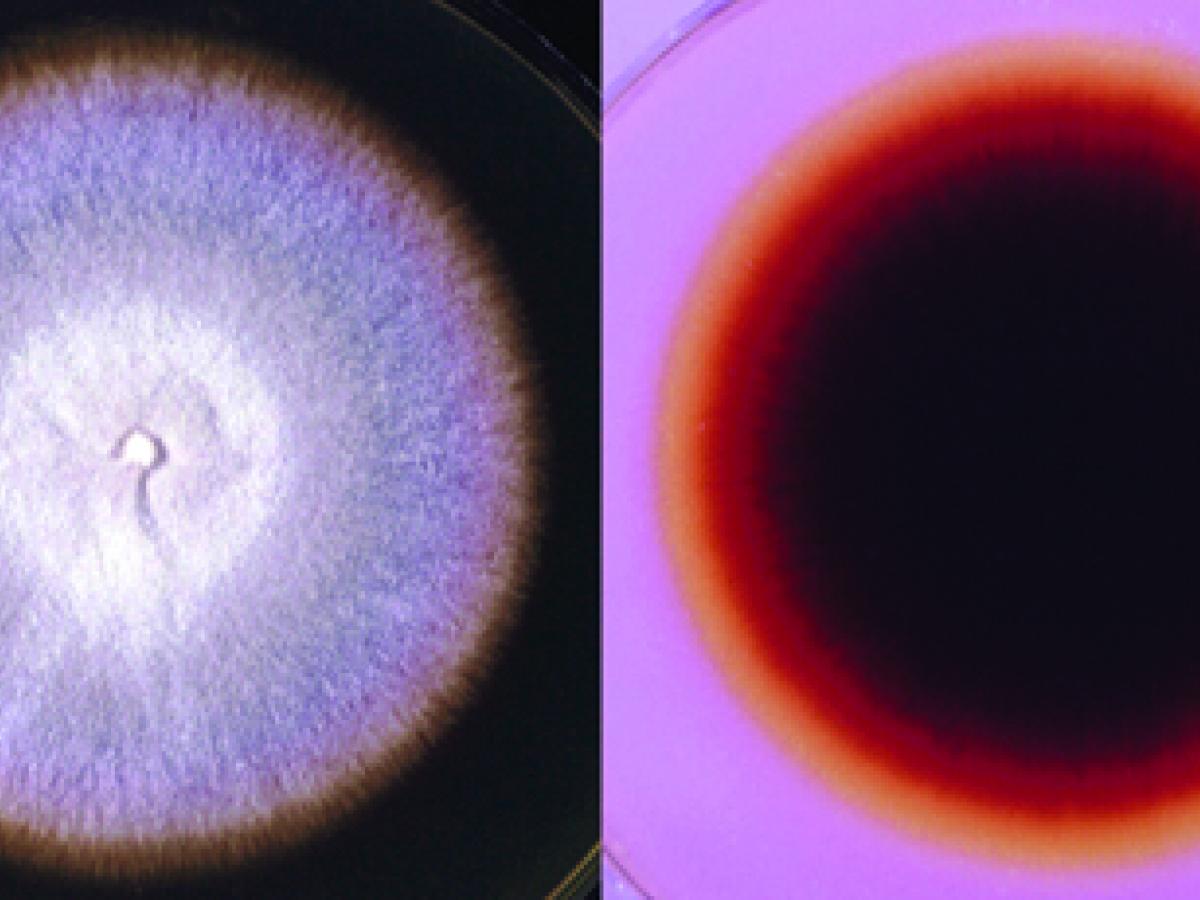
Culture of Trichophyton equinum.
Morphological description:
Colonies are usually flat, but some may develop gentle folds or radial grooves, white to buff in colour, suede-like to downy in texture, and are similar to T. mentagrophytes. Cultures usually have a deep-yellow submerged fringe and reverse which later becomes dark red in the centre. Microscopically: abundant microconidia which may be clavate to pyriform and sessile or spherical and stalked are formed laterally along the hyphae. Macroconidia are only rarely produced, but when present are clavate, smooth, thin-walled and of variable size. Occasional nodular organs may be present and the microconidia often undergo a transformation to produce abundant chlamydospores in old cultures.
Microconidia, macroconidia and nodular organs of T. equinum.
Confirmatory tests:
Lactritmel agar:
Flat spreading, white to cream-coloured, powdery to granular surface with a central downy papilla, and deep brownish-red reverse. Microscopic morphology as described above.Hydrolysis of urea:
Positive in 4-5 days.Nutritional tests on Trichophyton agars:
Most strains require nicotinic acid for growth except those from Australia and New Zealand, which are autotrophic.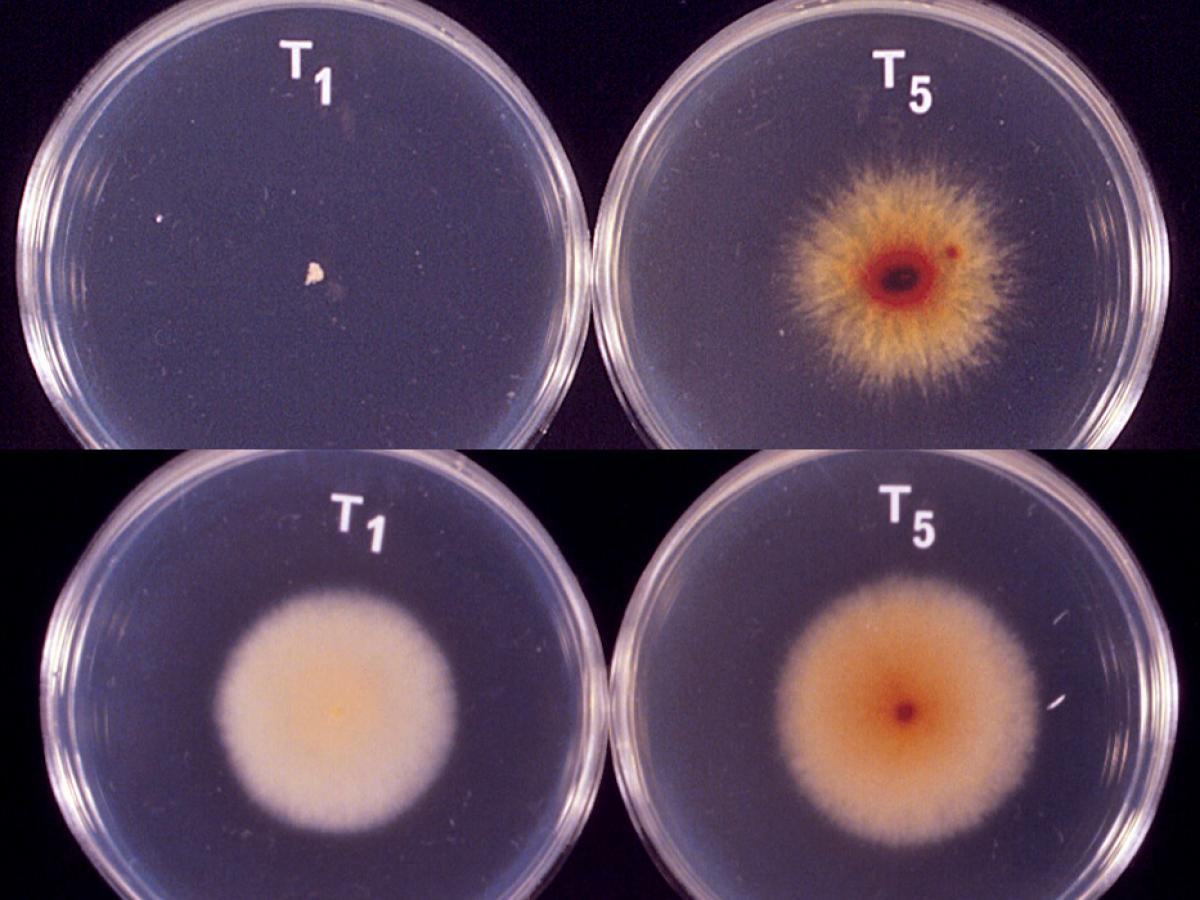
T. equinum showing no growth on T1 but good gowth on T5. T. equinumautotrophicum strain showing good growth on both T1 and T5.
Hair perforation test:
Negative; but positive for the autotrophicum strains.Molecular diagnostics:
Species identification supported by ITS sequencing (Gräser et al. 1999a; Chen et al. 2011).Key features:
Microscopic morphology, culture characteristics, nicotinic acid requirement and clinical lesions in horses. Most strains require nicotinic acid for growth except autotrophic strains. -
Trichophyton erinacei
Synonymy:
Trichophyton mentagrophytes var. erinacei.Trichophyton erinacei is a zoophilic fungus associated with hedgehogs and the epidermal mites, harboured by hedgehogs. Human infections occur most frequently on the exposed parts of the body, but tinea of the scalp and nails can also occur. Invaded hairs show an ectothrix infection but do not fluoresce under Wood’s ultra-violet light. The distribution of this fungus is New Zealand and Europe.
RG-2 organism.

Culture of Trichophyton erinacei showing its typical brilliant lemon yellow reverse pigment.
Morphological description:
Colonies are white, flat, powdery, sometimes downy to fluffy with a brilliant lemon-yellow reverse. Numerous large clavate microconidia are borne on the sides of hyphae. Macroconidia are smooth-walled, two to six-celled, clavate, variable in size, and may have terminal appendages. Macroconidia are much shorter than those seen in T. mentagrophytes.Confirmatory tests:
Lactritmel agar:
White suede-like to powdery colony with brilliant yellow reverse. Numerous large slender clavate microconidia.
Macroconidia and microconidia of Trichophyton erinacei.
Hydrolysis of urea:
Negative at 7 days.Vitamin free agar (Trichophyton agar No.1):
Good growth indicating no special nutritional requirements. Colonies are white suede-like to powdery with no reverse pigment.Hair perforation test:
Positive.Key features:
Include microscopic morphology and culture characteristics; slender clavate microconidia and brilliant lemon-yellow reverse pigment on SDA; and negative hydrolysis of urea.Trichophyton erinacei is generally distinguished from T. mentagrophytes by: (a) its microscopic morphology showing numerous large slender clavate microconidia borne on the sides of hyphae and its smooth, thin-walled clavate macroconidia; (b) its brilliant lemon yellow reverse pigment on SDA and lactritmel agar; (c) its lack of reverse pigment on Sabouraud’s salt agar; and (d) its negative hydrolysis of urea.
-
Trichophyton indotineae
The recently proposed species, Trichophyton indotineae is closely related to T. interdigitale, and likely represents another clonal offshoot of T. mentagrophytes. It is associated with terbinafine resistance and is increasingly being reported in India (Kano et al., 2020; Tang et al., 2021). While separation of T. indotineae and T. interdigitale is not reliable from morphological characteristics, T. indotineae typically has a negative urea hydrolysis result after 7 days, while T. interdigitale and T. mentagrophytes are typically positive (Tang et al., 2021).
Morphological description: Colonies are generally flat, white to cream in colour, with a powdery to granular surface. Reverse pigmentation is usually a light yellowish yellow brown colour. Numerous single-celled microconidia are formed, often in dense clusters. Microconidia are hyaline, smooth-walled, and are predominantly spherical to subspherical in shape, however occasional clavate to pyriform forms may occur. Varying numbers of spherical chlamydospores maybe present, spiral hyphae and smooth, thin-walled, clavate-shaped, to spindle-shaped multicelled macroconidia may also be present.

Trichophyton indotineae culture.

Trichophyton indotineae microconidia, macroconidia and spiral hyphae.
Confirmatory tests:
Hydrolysis of urea: Negative within 7 days. Tang et al. (2021) reported urea hydrolysis was mostly positive in T. interdigitale and T. mentagrophytes, while most strains of T. indotineae were weakly positive or negative.
Comment: Trichophyton indotineae is morphologically indistinguishable from T. interdigitale. Culture and microscopic characteristics overlap. A negative urease test may be a useful marker however, ITS genome sequencing will be necessary for a definitive identification.
Molecular identification: Species identification based on ITS sequencing. Note: some Australian laboratories have transitioned to molecular polymerase chain reaction based testing, which affords a more rapid turnaround time and increased sensitivity (Lin et al., 2021). However, the most widely used assay (Dermatophytes and other Fungi, AusDiagnostics) cannot currently differentiate T. indotineae from other members of the T. mentagrophytes/T. interdigitale species complex (Chua et al., 2024).
MALDI-ToF MS: Tang et al., (2022) showed that MALDI-TOF spectra belonging to T. indotineae could be distinguished from spectra of the other species of the T. mentagrophytes species complex, as they clustered together in a distant MALDI-TOF MS tree.
References:
Caplan, A.S., Todd, G.C., Zhu, Y. et al. (2024) Clinical Course, Antifungal Susceptibility, and Genomic Sequencing of Trichophyton indotineae. JAMA Dermatology. 160, 701–709.
Chua, K.Y.L., Halliday, C.L., Chen, S.C‐A. et al (2024) Treatment‐resistant tinea caused by Trichophyton indotineae in Australia. Medical Journal of Australia, 10.5694/ mja2.52386.
Kano, R., Kimura, U., Kakurai, M., et al. (2020) Trichophyton indotineae sp. nov.: a new highly terbinafine-resistant anthropophilic dermatophyte species. Mycopathologia, 185, 947-958.
Lin, B.B., Pattle, N., Kelley, P., Jaksic, A.S. (2021) Multiplex RT- PCR provides improved diagnosis of skin and nail dermatophyte infections compared to microscopy and culture: a laboratory study and review of the literature. Diagnostic Microbiology Infectious Disease 101, 115413.
Kong, X., Tang, C., Singh, A., et al. (2021) Antifungal Susceptibility and Mutations in the Squalene Epoxidase Gene in Dermatophytes of the Trichophyton mentagrophytes Species Complex. Antimicrobial Agents Chemotherapy 16, 65.
Lockhart,S.R., Smith, D.J., Gold, J.A.W. (2023) Trichophyton indotinea and other terbinafine-resistant dermatophytes in North America. Journal of Clinical Microbiology 61, e00903-23.
Normand, A.C., Moreno-Sabater, A., Jabet, A et al. (2022) MALDI-TOF Mass Spectrometry Online Identification of Trichophyton indotineae Using the MSI-2 Application. Journal of Fungi (Basel)19,1103.
Tang, C., Kong, X., Ahmed, S.A. et al. (2021) Taxonomy of the Trichophyton mentagrophytes/T. interdigitaleSpecies Complex Harboring the Highly Virulent, Multiresistant Genotype T. indotineae. Mycopathologia186, 315-326.
Tang C., Ahmed S.A., Deng S., et al. (2022). Detection of Emerging Genotypes in Trichophyton mentagrophytes Species Complex: A Proposal for Handling Biodiversity in Dermatophytes. Frontiers in Microbiology 13, 960190.
Uhrlaß, S., Verma, S.B., Gräser, Y. et al. (2022) An Emerging Pathogen Causing Recalcitrant Dermatophytoses in India and Worldwide - A Multidimensional Perspective. Journal of Fungi 8, 757.
-
Trichophyton interdigitale

Vesicular tinea pedis caused by Trichophyton interdigitale.
Synonymy:
T. mentagrophytes var. interdigitale.Trichophyton interdigitale is an anthropophilic fungus which is a common cause of tinea pedis, particularly the vesicular type, tinea corporis, and sometimes superficial nail plate invasion in humans. It is not known to invade hair in vivo but produces hair perforations in vitro. Distribution is worldwide. This species may be regarded as a clonal offshoot of the zoophilic T. mentagrophytes (de Hoog et al.2016).
RG-2 organism.
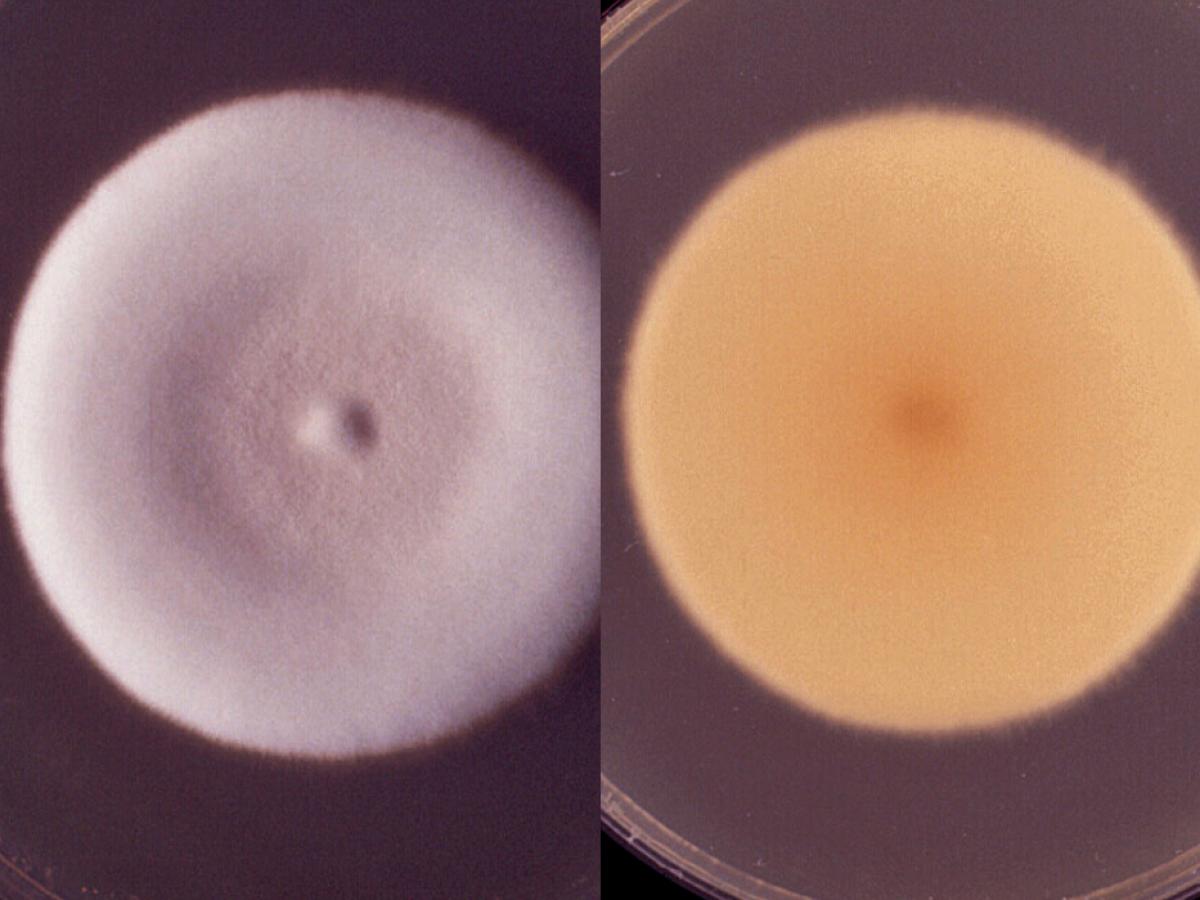
Culture of Trichophyton interdigitale.
Morphological description:
Colonies are usually flat, white to cream in colour with a powdery to suede-like surface and yellowish to pinkish brown reverse pigment, often becoming a darker red-brown with age. Numerous subspherical to pyriform microconidia, occasional spiral hyphae and spherical chlamydospores are present, the latter being more abundant in older cultures. Occasional slender, clavate, smooth-walled, multiseptate macroconidia are also present in some cultures.
Microconidia, macroconidia and spiral hyphae in T. interdigitale.
Confirmatory tests:
Littman oxgall agar:
Raised white downy colony with no reverse pigment.Lactritmel agar:
Macroscopic and microscopic features as described above.Sabouraud’s dextrose agar with 5% salt: Heaped and folded, buff-coloured, suede-like surface with a dark reddish-brown submerged fringe and brown reverse.
1% Peptone agar:
Flat, white to cream, suede-like surface with raised white downy centre. No reverse pigment.
Chlamydoconidia of T. interdigitale.
Vitamin free agar (Trichophyton agar No.1):
Good growth indicating no special nutritional requirements, flat cream powdery surface with central downy tuft. Reverse pale pinkish-brown.Hydrolysis of urea:
Positive within 7 days (usually 3 to 5 days).Hair perforation test:
Positive.Key features:
Culture characteristics, microscopic morphology and in vitro perforation of human hair.
Positive hair perforation test.
Trichophyton interdigitale can be distinguished from T. rubrum and T. mentagrophytes by: (a) its culture characteristics and microscopic morphology on SDA and/or lactritmel agar; (b) its growth and colony morphology on Sabouraud’s salt agar (colonies of T. interdigitale and T. mentagrophytes unlike T. rubrum, grow very well on this medium and usually produce a distinctive dark reddish-brown reverse pigment); (c) a positive urease test (within 7 days), a positive hair perforation test and the production of a yellow-brown to pinkish-brown reverse pigment on pigment stimulation media like lactritmel and Trichophyton No.1 agars; (d) T. interdigitale demonstrates profuse growth and alkalinity on BCP milk solids agar; (e) on 1% peptone agar T. interdigitale has a suede-like to downy surface whereas T. mentagrophytes has a characteristic granular appearance.

Trichophyton interdigitale (formerly var. nodulare).
A dysgonic variant of Trichophyton interdigitale (formerly var. nodulare); culture showing distinctive bright yellow to apricot-coloured colonies with a suede-like to powdery surface and a bright yellow-brown to orange reverse; and microscopically characteristic “nodular organs” are observed in the vegetative hyphae. Usually, no conidia are seen but some isolates, especially with subculture may produce subspherical to pyriform microconidia similar to those of T. interdigitale.
-
Trichophyton mentagrophytes

T. mentagrophytes infection in a kangaroo.
Synonymy:
T. mentagrophytes var. mentagrophytes.Trichophyton mentagrophytes is a zoophilic fungus with a worldwide distribution and a wide range of animal hosts including mice, guinea-pigs, kangaroos, cats, horses, sheep and rabbits. Produces inflammatory skin or scalp lesions in humans, particularly in rural workers. Kerion of the scalp and beard may occur. Invaded hairs show an ectothrix infection but do not fluoresce under Wood’s ultra-violet light. Distribution is worldwide.
RG-2 organism.

Cultures of Trichophyton mentagrophytes.
Morphological description:
Colonies are generally flat, white to cream in colour, with a powdery to granular surface. Some cultures show central folding or develop raised central tufts or pleomorphic suede-like to downy areas. Reverse pigmentation is usually a yellow-brown to reddish-brown colour. Numerous single-celled microconidia are formed, often in dense clusters. Microconidia are hyaline, smooth-walled, and are predominantly spherical to subspherical in shape, however occasional clavate to pyriform forms may occur. Varying numbers of spherical chlamydospores, spiral hyphae and smooth, thin-walled, clavate-shaped, multicelled macroconidia may also be present.
Microconidia and macroconidia of T. mentagrophytes.
Confirmatory tests:
Littman oxgall agar:
Raised greyish-white, suede-like to downy colony. Some cultures may show a diffusible yellow to brown pigment.Lactritmel agar:
Cultures are flat, white to cream in colour, with a powdery to granular surface. Some cultures develop raised central tufts or pleomorphic downy areas. Reverse pigmentation is yellow-brown to pinkish-brown to red-brown. Microscopic morphology similar to that described above, with predominantly spherical microconidia, often formed in dense clusters, and varying numbers of spherical chlamydospores, spiral hyphae and smooth, thin-walled, clavate, multiseptate macroconidia.
Chlamydospores and hyphal spirals in T. mentrographes.
Sabouraud’s dextrose agar with 5% salt:
Cultures are heaped and folded, buff to brown in colour, with a suede-like surface texture and characteristically have a very dark reddish-brown submerged peripheral fringe and reverse pigmentation.1% Peptone agar:
Flat, cream-coloured, powdery to granular colony with no reverse pigment.Hydrolysis of urea:
Positive within 7 days (usually 3 to 5 days).Vitamin free agar (Trichophyton agar No.1):
Good growth indicating no special nutritional requirements. Cultures are flat, cream-coloured, with a powdery to suede-like surface, and have a reddish-brown reverse pigmentation.Hair perforation test:
Positive within 14 days.Key features:
Culture characteristics, microscopic morphology and clinical disease with known animal contacts. T. mentagrophytes can be distinguished from T. interdigitale by: (a) its granular appearance on the 1% Peptone agar; (b) its microscopic morphology of more spherical microconidia and generally greater numbers of macroconidia; and (c) a yellow to brown diffusible pigment is often seen on the Littman oxgall agar. Both T. interdigitale and T. mentagrophytes demonstrate profuse growth and alkalinity on BCP milk solids agar. -
Trichophyton quinkeanum

Mouse favus showing scutula caused by T. quinckeanum.
Synonymy:
T. mentagrophytes var. quinckeanum.Trichophyton quinckeanum causes “mouse favus” on mice, seen as thick, yellow, saucer-shaped crusted lesions up to 1 cm in diameter called scutula. Invaded hairs are rarely seen but they may show either ectothrix or endothrix infection. Infected human hairs do not fluoresce under Wood’s ultra-violet light, but very occasional hairs from experimental lesions in guinea pigs have shown a pale yellow fluorescence. The geographical distribution of this dermatophyte is difficult to establish, but is probably worldwide. It is often associated with mice plagues in the Australian Wheat Belt.
RG-2 organism.

Culture of Trichophyton quinckeanum.
Morphological description:
Colonies are generally flat, white to cream in colour, with a powdery to granular surface. Some cultures show central folding or develop raised central tufts or pleomorphic suede-like to downy areas. Reverse pigmentation is usually a yellow-brown to reddish-brown colour. Numerous microconidia are borne laterally along the sides of hyphae, and are predominantly slender clavate when young. With age the microconidia become broader and pyriform to spherical in shape. Occasional to moderate numbers of smooth, thin-walled, multiseptate, clavate to cigar-shaped macroconidia may be present. Varying numbers of spherical chlamydospores and spiral hyphae may also be present.
Microconidia and macroconidia of Trichophyton quinckeanum.
Confirmatory tests:
Littman oxgall agar:
Raised, dome-like bluish-grey, suede-like colony with a narrow flat, greyish-white, suede-like border. No diffusible or reverse pigment is present.Lactritmel agar:
Flat, white to cream, suede-like to powdery colony with either no reverse pigment or a pale yellow-brown to pinkish-brown reverse. Numerous slender clavate to pyriform (depending on age of subculture) microconidia and occasional to moderate numbers of smooth, thin-walled, clavate macroconidia are present.Sabouraud’s dextrose agar with 5% salt:
Heaped and much folded white suede-like colony with very pale yellow-brown reverse. No submerged fringe.1% Peptone agar:
Raised white suede-like to downy colony with no reverse pigment.Hydrolysis of urea: Positive within 7 days (usually very rapid 2-3 days).
Vitamin free agar (Trichophyton agar No.1):
Flat, white to cream, suede-like colony with either no reverse pigment or a pale yellow-brown reverse, i.e. no special nutritional requirements.Hair perforation test:
Positive in 7 to 10 days.Key features:
Culture characteristics, microscopic morphology, and rapid urease test.Trichophyton quinckeanum may be distinguished from T. mentagrophytes by: (a) its characteristic culture appearance on Littman oxgall agar (i.e. raised, dome-like, bluish-grey suede-like colony with a narrow flat, greyish-white, suede-like border and no diffusible or reverse pigment) and on Sabouraud’s 5% salt agar (typically heaped and folded white suede-like colony, but with no distinctive dark reddish-brown submerged fringe and reverse pigment as seen on T. mentagrophytes); (b) microscopic morphology showing numerous slender clavate with some pyriform microconidia and moderate numbers of smooth thin-walled, clavate macroconidia; and (c) a rapid urease test, usually positive within 2 to 3 days.
-
Trichophyton rubrum
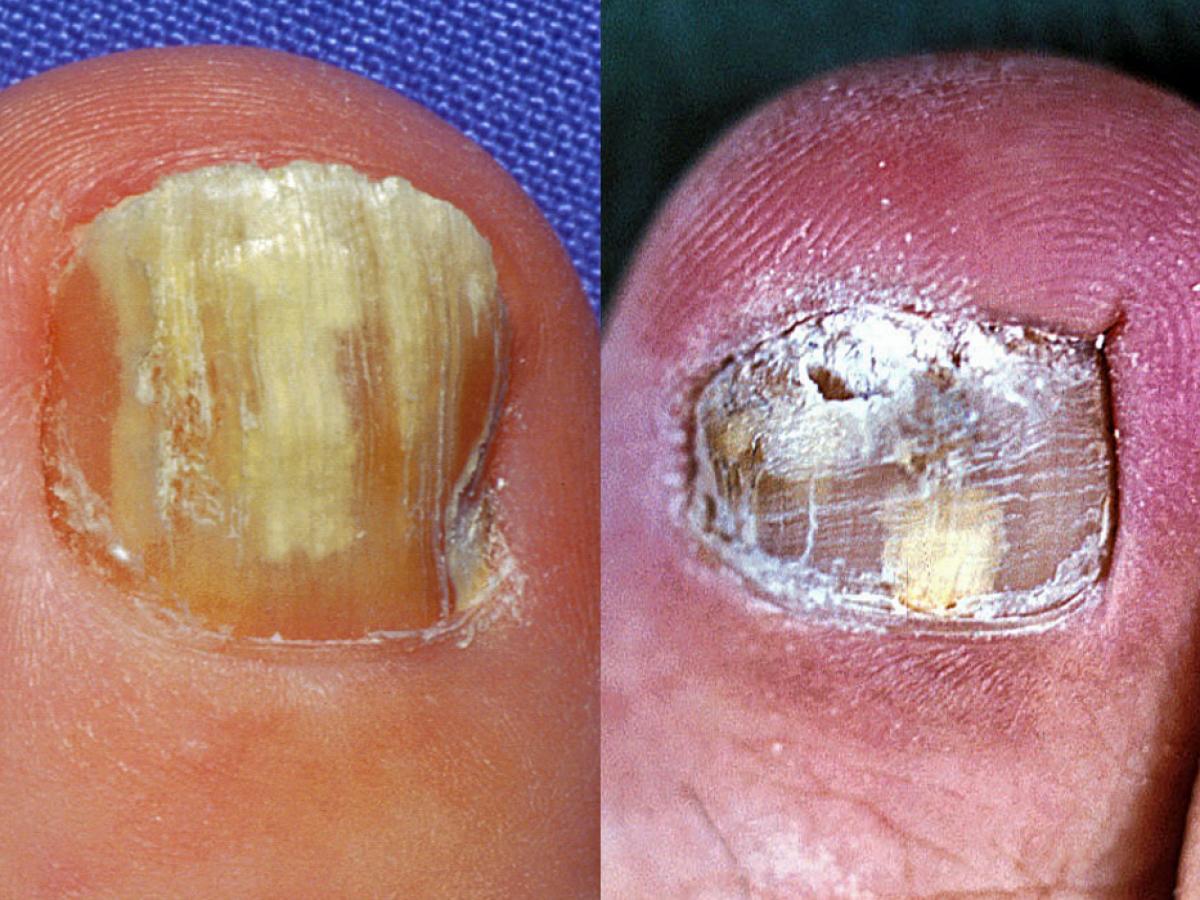
Onychomycosis caused by Trichophyton rubrum.
Synonymy:
Trichophyton fischeri, Trichophyton raubitschekii, Trichophyton kanei and all varieties of T. rubrum.Trichophyton rubrum is an anthropophilic fungus that has become the most widely distributed dermatophyte of humans. It frequently causes chronic infections of skin, nails and rarely scalp. Granulomatous lesions may sometimes occur. Infected hairs do not fluoresce under Wood’s ultraviolet light, and microscopically may show endothrix or ectothrix type of invasion.

Trichophyton rubrum culture morphology; downy strain with typical wine-red reverse; Y variety with both yellow and red pigmentation and var. flava with yellow pigmentation.
Morphologically T. rubrum exhibits a spectrum of overlapping characters; for example culture surface texture may vary from downy to suede-like; culture surface pigmentation may vary from white to cream to deep red; culture reverse pigmentation may vary from colourless to yellowish to yellow-brown to wine red; numbers of microconidia range from none to scanty to many; shape of microconidia vary from slender clavate to pyriform; numbers of macroconidia range from none to scanty to many and may or may not have terminal projections. This is why so many varieties or synonyms have been described in the past. However, molecular evidence by Gräser et al. (1999b) reveals little variation between strains of T. rubrum and determined that the species is largely clonal.

Trichophyton rubrum culture morphology of the granular strain with red surface and reverse pigmentation.
The majority of isolates, especially those causing tinea pedis and onychomycosis, are characterised by the production of scanty to moderate numbers of slender clavate microconidia and no macroconidia (formerly the “downy strain”). Some isolates, usually from cases of tinea corporis, are characterised by the production of moderate to abundant numbers of clavate to pyriform microconidia and moderate to abundant numbers of thin-walled, cigar-shaped macroconidia (formerly the “granular strain”).
It should be stressed that intermediate strains do occur as many culture and morphological characteristics overlap.

Trichophyton rubrum produces both red and yellow pigments. The images above show the same strain grown on lactritmel agar that promotes red pigmentation and on mycobiotic agar that shows an underlying yellow pigmentation.
Note: Trichophyton rubrum produces both red and yellow pigments. Culture colours may range from none to dark red to dark yellow, with all combinations in between. The images above show the same strain grown on lactritmel agar that promotes red pigmentation and on mycobiotic agar that shows an underlying yellow pigmentation.
RG-2 organism.

Trichophyton rubrum showing typical slender clavate microconidia.
Morphological description:
Colonies are mostly flat to slightly raised, white to cream, suede-like to downy, with either no reverse pigment or a yellow-brown to wine-red reverse. Most cultures show scanty to moderate numbers of slender clavate to pyriform microconidia. Macroconidia are usually absent, but when present are smooth, thin-walled multiseptate, slender and cylindrical to cigar-shaped. Older cultures may show numerous chlamydospores with a few clavate to pyriform microconidia.Note: On primary isolation some cultures may lack reverse pigmentation and fail to produce microconidia. These need to be subcultured onto media like lactritmel agar or potato dextrose agar, which stimulate pigmentation and sporulation. If sporulation still fails subculture the fungus onto Trichophyton agar No.1.

Trichophyton rubrum showing slender clavate microconidia and cigar-shaped macroconidia, some with terminal appendages.
Confirmatory tests:
Littman oxgall agar:
Raised, greyish-white, suede-like to downy colony with no reverse pigment. Some cultures may show a greenish-yellow diffusible pigment.Lactritmel agar:
Flat, white to rose pink, downy to granular colonies with a deep wine-red reverse pigment.Sabouraud’s dextrose agar with 5% salt:
Very stunted, white to cream, downy to glabrous colony with a pale yellow-brown reverse pigment.1% Peptone agar:
Flat, white to cream, downy to glabrous colony with no reverse pigment.BCP agar:
restricted colony growth and neutral (unchanged) pH. Colonies typically demonstrate red pigment on reverseHydrolysis of urea:
Typically, negative at 7 days (some may be positive).Vitamin free agar (Trichophyton agar No.1):
Good growth indicating no special vitamin requirements. Colonies are flat, white to cream, suede-like to downy with a deep wine-red reverse pigment.Hair perforation test:
Negative at 28 days.Key features:
Include clinical history, culture characteristics, microscopic morphology and failure to perforate hair in vitro. -
Trichophyton schoenleinii

Favus caused by Trichophyton schoenleinii.
Trichophyton schoenleinii is an anthropophilic fungus causing favus in humans. Favus is a chronic, scarring form of tinea capitis characterised by saucer-shaped crusted lesions or scutula and permanent hair loss. Invaded hairs remain intact and fluoresce a pale greenish-yellow under Wood’s ultra-violet light. Favus was once common in Eurasia and North Africa, however its incidence is now in decline.
RG-2 organism.
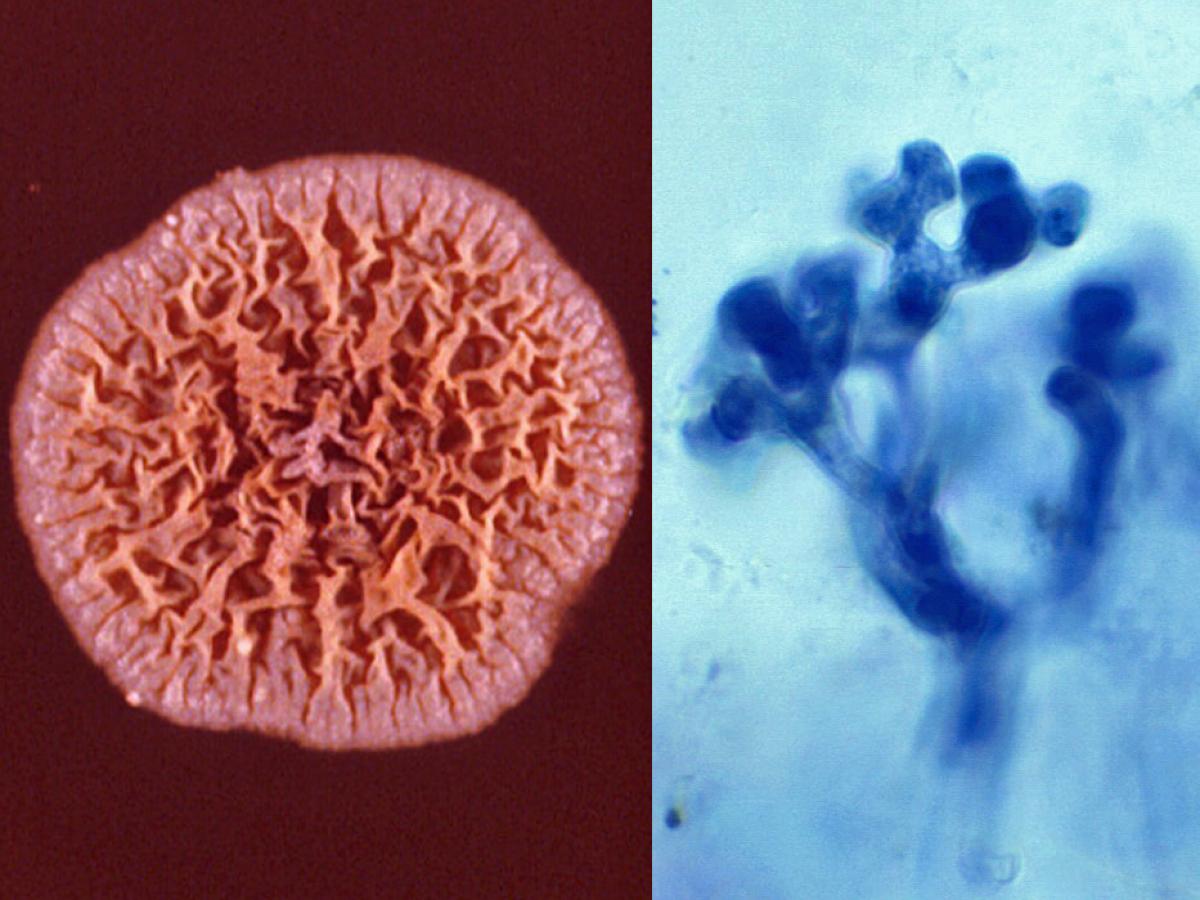
Culture of T. schoenleinii and microscopy showing favic chandeliers.
Morphological description:
Colonies are slow growing, waxy or suede-like with a deeply folded honey-comb-like thallus and some subsurface growth. The thallus is cream-coloured to yellow to orange brown. Cultures are difficult to maintain in their typical convoluted form, and rapidly become flat and downy. No reverse pigmentation is present. No macroconidia and microconidia are seen in routine cultures, and numerous chlamydospores may be present in older cultures. Characteristic antler “nail head” hyphae, also known as “favic chandeliers”, may be observed. A few distorted clavate microconidia may be formed by some isolates when grown on polished rice grains.Key features:
Clinical history, culture characteristics and microscopic morphology showing “favic chandeliers”. -
Trichophyton soudanense
Trichophyton soudanense is an anthropophilic fungus that is a frequent cause of tinea capitis in Africa. Invaded hairs show an endothrix infection but do not fluoresce under Wood’s ultra-violet light. Distribution is mainly in Africa with imported cases now reported from Europe, Brazil, Australia and USA.
RG-2 organism.

Culture of T. soudanense and microscopy showing reflex hyphal branching.
Morphological description:
Colonies are slow-growing with a flat to folded, suede-like surface. Often there is a broad fringe of submerged growth. Surface mycelium and reverse pigment are characteristically a deep apricot-orange in colour. Microscopically, the hyphae often show reflexive or right-angle branching. Pyriform microconidia may occasionally be present and numerous chlamydospores are often found in older cultures.Note: T. soudanense demonstrates profuse growth and alkalinity on BCP milk solids agar. A thin halo of clearing usually appears in the milk solids around the colony edge at 7-10 days.
Key features:
Clinical history, culture characteristics and microscopic morphology showing reflexive hyphal branching and endothrix invasion of hair. -
Trichophyton tonsurans

Tinea capitis caused by Trichophyton tonsurans.
Trichophyton tonsurans is an anthropophilic fungus with a worldwide distribution which causes inflammatory or chronic non-inflammatory finely scaling lesions of skin, nails and scalp. It is a common cause of tinea capitis in Australian Aborigines and African Americans. Invaded hairs show an endothrix infection and do not fluoresce under Wood’s ultra-violet light.
RG-2 organism.

T. tonsurans cultures show considerable variation in texture and colour. The colour may vary from pale-buff to yellow to dark-brown. The reverse colour varies from yellow-brown to reddish-brown to deep mahogany.
Morphological description:
Colonies show considerable variation in texture and colour. They may be suede-like to powdery, flat with a raised centre or folded, often with radial grooves. The colour may vary from pale-buff to yellow, (the sulfureum form which resembles Epidermophyton floccosum), to dark-brown. The reverse colour varies from yellow-brown to reddish-brown to deep mahogany. Hyphae are relatively broad, irregular, much branched with numerous septa. Numerous characteristic microconidia varying in size and shape from long clavate to broad pyriform, are borne at right angles to the hyphae, which often remain unstained by lactophenol cotton blue. Very occasional smooth, thin-walled, irregular, clavate macroconidia may be present on some cultures. Numerous swollen giant forms of microconidia and chlamydospores are produced in older cultures.
T. tonsurans hyphae, microconidia and macroconidia.
Confirmatory tests:
Mycosel agar:
Chlamydospore-like structures produced by 5 days is characteristic of T. tonsurans (Mochizuki et al. 2013).Hydrolysis of urea: positive at 5 days.
Nutritional tests on Trichophyton agars:
Results demonstrate a partial requirement for (a) thiamine. T1 = vitamin free agar, (b) T4 = vitamin free + thiamine agar.
T. tonsurans showing good growth on T4 agar indicating a requirement for thiamine.
Hair perforation test:
Positive within 14 days.Key features:
Microscopic morphology, culture characteristics, endothrix invasion of hairs and partial thiamine requirement.References:
Rebell and Taplin (1970), Ajello (1972), Vanbreusegham et al. (1978), Rippon (1988), McGinnis (1980), Domsch et al. (1980), Kane et al. (1997) and de Hoog et al. (2000, 2015). -
Trichophyton verrucosum

Dermatophytosis in cattle caused by Trichophyton verrucosum.
Trichophyton verrucosum is a zoophilic fungus causing ringworm in cattle. Infections in humans result from direct contact with cattle or infected fomites and are usually highly inflammatory involving the scalp, beard or exposed areas of the body. Invaded hairs show an ectothrix infection and fluorescence under Wood’s ultra-violet light has been noted in cattle but not in humans. Distribution is worldwide.
RG-2 organism.

T. verrucosum young button-shaped colonies and mature culture.
Morphological description:
Colonies are slow growing, small, button or disk-shaped, white to cream-coloured, with a suede-like to velvety surface, a raised centre, and flat periphery with some submerged growth. Reverse pigment may vary from non-pigmented to yellow. Broad, irregular hyphae with many terminal and intercalary chlamydospores. Chlamydospores are often in chains. The tips of some hyphae are broad and club-shaped, and occasionally divided, giving the so-called “antler” effect. When grown on thiamine-enriched media, occasional strains produce clavate to pyriform microconidia borne singly along the hyphae. Macroconidia are only rarely produced, but when present have a characteristic tail or string bean shape.
Clavate to pyriform microconidia and characteristic rat tail or string bean shaped macroconidia of T. verrucosum.
Confirmatory tests:
Growth at 37C:
Unlike other dermatophytes, growth is enhanced at 37C.Nutritional requirements:
All strains require thiamine and approximately 80% require thiamine and inositol. There is no growth on casein vitamin free agar (T1), minimal submerged growth on T1 + inositol (T2), good growth on T1 + inositol and thiamine (T3) and good growth on T1 + thiamine only (T4).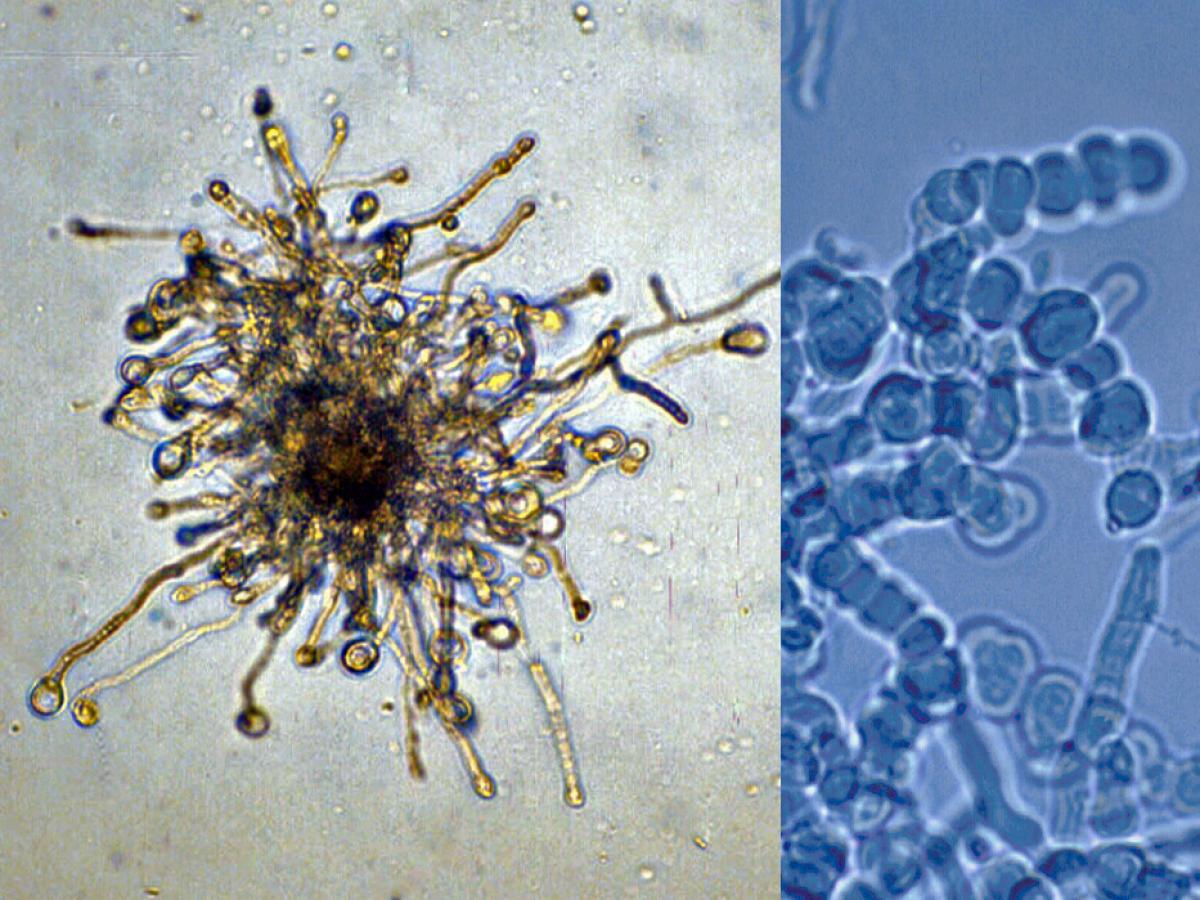
Characteristic terminal vesicles at the tips of hyphae and chains of chlamydoconidia of T. verrucosum.
All strains produce typical chains of chlamydospores, often referred to as “chains of pearls”, especially when grown on BCP milk solids glucose agar at 37C. When grown at 25C on milk solids glucose agar a “halo”-like zone of peripheral clearing of milk solids occurs within 7 days.
Microscopic examination of young colonies (4 to 5 day old), grown from a very small inoculum, on Sabouraud’s dextrose agar containing 0.5% yeast extract and incubated at 30C, show characteristic terminal vesicles (not chlamydospores) at the tips of hyphae. The number of vesicles produced is greater from primary inoculations of skin scrapings or hairs than from subcultures.
Key features:
Culture characteristics and requirements for thiamine and inositol, large ectothrix invasion of hair, clinical lesions and history. -
Trichophyton violaceum

Black dot tinea caused by Trichophyton violaceum.
Synonymy: Trichophyton yaounde and all varieties of T. violaceum.
Trichophyton violaceum is an anthropophilic fungus causing inflammatory or chronic non-inflammatory finely scaling lesions of skin, nails, beard and scalp, producing the so-called “black dot” tinea capitis. Distribution is worldwide, particularly in the Near East, Eastern Europe, Russia and North Africa. Invaded hairs show an endothrix infection and do not fluoresce under Wood’s ultra-violet light.
RG-2 organism.

Culture and hyphal chlamydoconidia of T. violaceum.
Morphological description:
Colonies are very slow growing, glabrous or waxy, heaped and folded and deep violet in colour. Cultures often become pleomorphic, forming white sectors. Occasional non-pigmented strains may occur. Hyphae are relatively broad, tortuous, much branched and distorted. Young hyphae usually stain well in lactophenol cotton blue, whereas older hyphae stain poorly and show small central fat globules and granules. Typically, no conidia are present, although occasional pyriform microconidia have been observed on enriched media. Numerous chlamydospores are usually present, especially in older cultures.Nutritional requirements:
T. violaceum has a partial nutrient requirement for thiamine. There is minimal growth on casein vitamin-free agar (T1), and slightly better growth on vitamin-free agar plus thiamine (T4). The partial requirement for thiamine separates this organism from T. rubrum, and other species that may produce purple pigmented colonies.Key features:
Culture characteristics, partial thiamine requirement and endothrix hair invasion.
-
Laboratory Identification
The genus Trichophyton is characterised morphologically by the development of both smooth-walled macro- and microconidia. Macroconidia are mostly borne laterally directly on the hyphae or on short pedicels, and are thin- or thick-walled, clavate to fusiform, and range from 4-8 x 8-50 μm in size. Macroconidia are few or absent in many species. Microconidia are spherical, pyriform to clavate or of irregular shape and range from 2-3 x 2-4 μm in size. The presence of microconidia differentiates this genus from Epidermophyton, and the smooth-walled, mostly sessile macroconidia differentiates it from Lophophyton, Microsporum, Nannizzia and Paraphyton.
In practice, two groups may be recognised on direct microscopy:
1. Those species that usually produce microconidia; macroconidia may or may not be present i.e. T. rubrum, T. interdigitale, T. mentagrophytes, T. equinum, T. erinacei, T. tonsurans, and to a lesser extent T. verrucosum, which may produce conidia on some media. In these species the shape, size and arrangement of the microconidia is the most important character. Culture characteristics are also useful.
2. Those species that usually do not produce conidia. Chlamydospores or other hyphal structures may be present, but microscopy is generally non-diagnostic; i.e. T. verrucosum, T. violaceum, T. concentricum, T. schoenleinii and T. soudanense. Culture characteristics and clinical information such as the site, appearance of the lesion, geographic location, travel history, animal contacts and even occupation are most important.
Many laboratories have used growth on additional media and/or confirmatory tests to help differentiate between species of Trichophyton, especially isolates of T. rubrum, T. interdigitale, T. mentagrophytes and T. tonsurans.These include growth characteristics on media such as Littman oxgall agar, lactritmel agar, potato dextrose agar, Sabouraud’s agar with 5% Salt, 1% peptone agar, bromocresol purple-milk solids glucose agar (BCP), Trichophyton agars No. 1-5, hydrolysis of urea and hair perforation tests.
Molecular identification:
ITS and EF-1α sequencing is recommended for accurate species identification (Gräser et al. 1998, 1999b, 2000a, 2008; Irinyi et al. 2015; Mirhendi et al. 2015).MALDI-TOF MS:
Methods reported by Erhard et al. (2008), Nenoff et al. (2011), Cassange et al. (2011), l’Ollivier et al. (2013), Calderaro et al. (2014), Packeu et al. (2013, 2014).References:
Rebell and Taplin (1970), Ajello (1972), Vanbreusegham et al. (1978), Rippon (1988), McGinnis (1980), Domsch et al. (1980), Kane et al. (1997), Chen et al. (2011), de Hoog et al. (2000, 2015, 2016).
